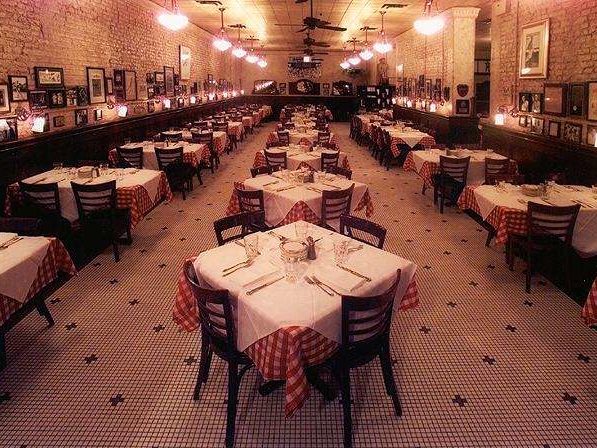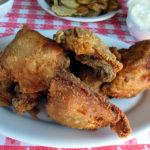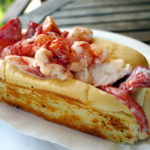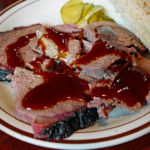The Past on a Plate
CHICAGO'S LIVELIEST culinary sport is rating city specialties. Food journalists and freelance eaters are forever debating whose Red Hots, deep-dish pizzas, Italian beef, and rib racks are the best. From street vendors to four-star dining rooms, untold numbers of food purveyors unblushingly tout their fare as Chicago's best. Curiously, despite this patent gastronomic pride, two of the most beloved local specialties remain above the ratings game. Shrimp de Jonghe and chicken Vesuvio share an abundance of garlic but little else. They are served in old-time steak houses and fine neighborhood Italian restaurants as well as at dinner tables in homes of diverse ethnic backgrounds. They are as fundamental a part of Chicago food life as a flaming dinner in the Pump Room or a Maxwell Street Polish sausage, yet so basic to the city's taste that they fly below the ratings radar.

By Jane and Micheal Stern
Originally Published 2000 Gourmet Magazine
CHICAGO’S LIVELIEST culinary sport is rating city specialties. Food journalists and freelance eaters are forever debating whose Red Hots, deep-dish pizzas, Italian beef, and rib racks are the best. From street vendors to four-star dining rooms, untold numbers of food purveyors unblushingly tout their fare as Chicago’s best. Curiously, despite this patent gastronomic pride, two of the most beloved local specialties remain above the ratings game. Shrimp de Jonghe and chicken Vesuvio share an abundance of garlic but little else. They are served in old-time steak houses and fine neighborhood Italian restaurants as well as at dinner tables in homes of diverse ethnic backgrounds. They are as fundamental a part of Chicago food life as a flaming dinner in the Pump Room or a Maxwell Street Polish sausage, yet so basic to the city’s taste that they fly below the ratings radar.
Many of us who grew up along Lake Michigan’s southwest shore take them for granted, and they may even fade from our memories if we move away to eat through other towns and new cuisines. But to inhale the sweet Sherry—garlic aroma of a shrimp de Jonghe casserole or the starchy warmth of crisp-crusted potatoes in a well-prepared plate of chicken Vesuvio is like sniffing the perfume of a long-lost love.
And so, to ex-Chicagoans as well as to visitors who want a true Chicago meal, we are delighted to report that both dishes remain a staple in dining rooms that are bastions of the old ways; they also appear on menus of newer restaurants where chefs respect tradition.
The Vesuvio way of doing things is a passion at Harry Caray’s, which was opened in 1987 by the late sportscaster who was known as the voice of the Chicago Cubs (it boasts a phone number honoring his most famous exclamation: 773-holy-cow). In this festive, brick-walled dining hall—patronized by Windy City glitterati, sports stars, tourists, and devotees of prime beef—you can get any steak in the house served Vesuvio style, as well as archetypal chicken Vesuvio and the less soulful boneless white-meat Vesuvio. The menu warns that the old-time version takes 30 minutes to prepare, and when you apply silverware to it, you understand why. The chicken, sautéed and then baked, is encased in a dark, red-gold crust of lush skin that slides from the meat as the meat slides off the bone. Piled among the chicken pieces are wedges of potato, long cooked in a bath of white wine, garlic, olive oil, and oregano until they are soft as mashed inside but develop luscious crunchy edges. Spilled across this powerfully seasoned mountain of food is a handful of green peas, more for color than for taste. Steaks Vesuvio are grilled to order in a traditional manner, then smothered with potatoes and peas that have been given the white wine, herb, and garlic treatment.
It will come as no surprise to epicures who know Chicago that superb versions of both chicken Vesuvio and shrimp de Jonghe are on the menu at the restaurant that also happens to serve the city’s best steak, the venerable Gene & Georgetti. Here we are reminded that chicken Vesuvio was supposedly named not only for its eruption of flavors but also because it really looks like a great volcano—a lofty jumble of crusty potatoes and glistening sections of chicken rising up from a pool of the garlic-tinged white wine in which they have been cooked. The skin, plastered with herbs and permeated with the savor of chicken fat, looks like strips of crispy-fried bacon.
Shrimp de Jonghe at Gene & Georgetti is unusual. Traditionally, the dish is cooked at a high temperature so that the garlicky crumbs form a crust around the edge of the ramekin, and is served oven-hot. Scraping off sizzling crust is part of the pleasure of great shrimp de Jonghe. However, you’ll do no scraping at Gene & Georgetti, for its version is not just a baked casserole. It is a broad, deep platter that holds melted herbed garlic butter laced with crumbs so soft they have become supple specks of flavor. You can cut the huge pink shrimp into bite-size pieces with a knife and fork, but you also need a spoon, or plenty of Gene & Georgetti’s stout Italian bread for mopping all that garlic butter. If you are willing to spend almost twice the price of a two-pound porterhouse steak, the lobster de Jonghe is a veritable seascape of plump white hunks of sweet tail meat in a luminous pool of butter. This dish is so rich it is dizzying.
IN THE FINE OLD Cape Cod Room of the Drake Hotel, we witness a shrimp de Jonghe epiphany that reminds us that food culture is a reflection not only of social history but of personal history, too. Ensconced in the dimly lit, Down East—decorated dining room with its red-checked curtains and anachronistic menu of Thermidors and Newburgs and wonderful Dover sole, we eavesdrop on the adjacent booth as a man says, “I don’t know how it happened. I just don’t know. I must be the luckiest man in Chicago.” Glasses clink, and he toasts his wife on the occasion of their 49th anniversary. At this moment, the aroma of Sherry and garlic begins to fill the air as two casseroles arrive at their table. “Shrimp de Jonghe!” the man exclaims tenderly, as if greeting a beloved grandparent, explaining to the waiter that this has been their anniversary meal since the day he and his wife were married in 1950.
In fact, shrimp de Jonghe tastes as if it goes back far earlier than 1950, back to the heyday of the chafing dish and shrimp wiggle. Historians have been unable to convincingly document its exact origins, but according to Pierre de Jonghe’s granddaughter Nancy Buckley, Pierre and his siblings opened de Jonghe’s restaurant at the 1893 Columbian Exposition and later moved to Monroe Street in downtown Chicago. It was at their restaurant that shrimp de Jonghe was created, by Pierre or perhaps by Pierre and his employee Emil Zehr. Zehr’s son, a professional accordionist, wrote us several years ago to say he was quite certain it was his father who invented it, a possibility Buckley allows.
Our happiest moment in the hunt for shrimp de Jonghe and chicken Vesuvio comes at Eli’s, an urbane Gold Coast steak house with a Jewish accent. It is just the sort of mature place we’d expect to find Chicago’s signature dishes in their glory. Sure enough, when we call to inquire, a hostess attests that shrimp.de Jonghe is on the dinner menu every night. And chicken Vesuvio?
“Ohhhh, dear, no,” she says with a voice full of genuine woe. “We used to make it. I am so sorry, so, so sorry.”
Seated at a white-linen–clad table in Eli’s small, privileged dining room (hey, there’s Chicago Sun-Times columnist Iry Kupcinet at a table near the door!), we ask the waiter about chicken Vesuvio, explaining that we are from out of town and yearn to try this true Chicago meal.
“I regret to say we don’t have it,” says the young man, also distressed at having to give a negative answer in this accommodating place. “We used to make it,” he recalls, then says, “Wait, wait right here,” and disappears. We scarcely have time to spread a slice of fresh pumper-nickel with chopped liver, crumbled egg, and onion before he returns. He is exultant. “We will make chicken Vesuvio!” he announces loud enough for diners at the next table to look up from their plates of calf’s liver.
Eli’s shrimp de Jonghe is expert—large, snapping-fresh shrimp sheathed in a red-gold coat of moist Sherry and garlic infused crumbs, served in a hot gratin dish. And the custom-made Vesuvio is nothing short of wondrous. Piled onto a big round plate is nearly a whole chicken, cut in pieces, cooked in white wine, garlic, and herbs until falling-apart tender, its skin roasted to savory ambrosia. The meat is intertwined with large segments of potato, also spangled with herbs. Some lengths of spud are so supple that they seem to pour along the pile of chicken like rivulets of molten lava and must be gathered with a fork and knife; others are cooked so brittle-crisp you can pick them up like steak fries. The dining room captain, other waiters, and a handful of knowing diners all watch the arrival of the chicken Vesuvio with awe, and they beam when we cannot contain our exclamations of pleasure as we begin to work our way through this magnificent meal.
After we finish supper and walk toward the door, Iry Kupcinet raises a glass to salute us. At the door, the maitre d’ asks if we found the dish satisfactory.
“Perfect!” we answer. “It was the chicken Vesuvio of our dreams.”
“I made sure of that,” he says with pride. “I was in the kitchen, watching.”
Cape Cod Room (permanently closed)
140 East Walton Street (in the Drake Hotel)
Chicago, IL
Eli’s The Place For Steak (permanently closed)
215 East Chicago Avenue
Chicago, IL
Discuss
What do you think of The Past on a Plate?
Related Articles
Stroud’s
By Jane and Michael Stern Originally Published 1995 Gourmet Magazine Chicken...
The Lobster Roll Honor Roll
Maine is the only state in America that features a picture of cooked food on its license...
Meat-And-Three
A few years back, country singer Ray Stevens invited a New York friend to join him at one of...
Top 12 favorite Ice Cream Scoops
WITH THE EXCEPTION of the hot dog bun, there has never been an edible invention as...
Top 5 BBQ Restaurants | Western Kentucky
Get yourself to Western Kentucky for great BBQ I see the food shows on TV where...
Best restaurants in Greenwood, MS | Hot Licks Delta Style
Ever since we first ate margarine-sauced pompano at Lusco’s, in Greenwood,...






